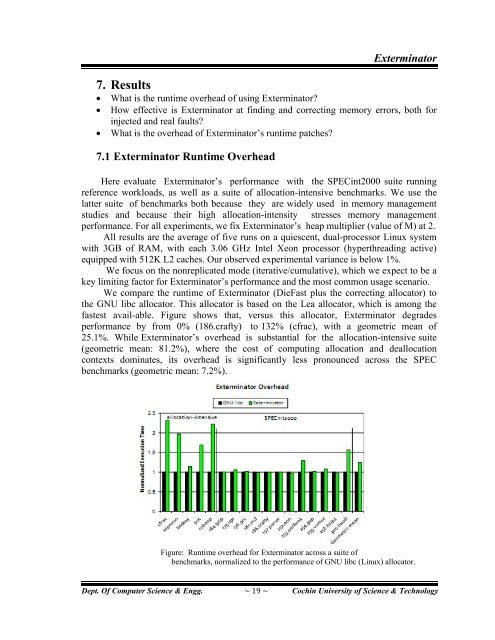Exterminator- A ... with High Probability.pdf - DSpace at CUSAT ...
Exterminator- A ... with High Probability.pdf - DSpace at CUSAT ...
Exterminator- A ... with High Probability.pdf - DSpace at CUSAT ...
Create successful ePaper yourself
Turn your PDF publications into a flip-book with our unique Google optimized e-Paper software.
<strong>Extermin<strong>at</strong>or</strong><br />
7. Results<br />
Wh<strong>at</strong> is the runtime overhead of using <strong>Extermin<strong>at</strong>or</strong>?<br />
How effective is <strong>Extermin<strong>at</strong>or</strong> <strong>at</strong> finding and correcting memory errors, both for<br />
injected and real faults?<br />
Wh<strong>at</strong> is the overhead of <strong>Extermin<strong>at</strong>or</strong>’s runtime p<strong>at</strong>ches?<br />
7.1 <strong>Extermin<strong>at</strong>or</strong> Runtime Overhead<br />
Here evalu<strong>at</strong>e <strong>Extermin<strong>at</strong>or</strong>’s performance <strong>with</strong> the SPECint2000 suite running<br />
reference workloads, as well as a suite of alloc<strong>at</strong>ion-intensive benchmarks. We use the<br />
l<strong>at</strong>ter suite of benchmarks both because they are widely used in memory management<br />
studies and because their high alloc<strong>at</strong>ion-intensity stresses memory management<br />
performance. For all experiments, we fix <strong>Extermin<strong>at</strong>or</strong>’s heap multiplier (value of M) <strong>at</strong> 2.<br />
All results are the average of five runs on a quiescent, dual-processor Linux system<br />
<strong>with</strong> 3GB of RAM, <strong>with</strong> each 3.06 GHz Intel Xeon processor (hyperthreading active)<br />
equipped <strong>with</strong> 512K L2 caches. Our observed experimental variance is below 1%.<br />
We focus on the nonreplic<strong>at</strong>ed mode (iter<strong>at</strong>ive/cumul<strong>at</strong>ive), which we expect to be a<br />
key limiting factor for <strong>Extermin<strong>at</strong>or</strong>’s performance and the most common usage scenario.<br />
We compare the runtime of <strong>Extermin<strong>at</strong>or</strong> (DieFast plus the correcting alloc<strong>at</strong>or) to<br />
the GNU libc alloc<strong>at</strong>or. This alloc<strong>at</strong>or is based on the Lea alloc<strong>at</strong>or, which is among the<br />
fastest avail-able. Figure shows th<strong>at</strong>, versus this alloc<strong>at</strong>or, <strong>Extermin<strong>at</strong>or</strong> degrades<br />
performance by from 0% (186.crafty) to 132% (cfrac), <strong>with</strong> a geometric mean of<br />
25.1%. While <strong>Extermin<strong>at</strong>or</strong>’s overhead is substantial for the alloc<strong>at</strong>ion-intensive suite<br />
(geometric mean: 81.2%), where the cost of computing alloc<strong>at</strong>ion and dealloc<strong>at</strong>ion<br />
contexts domin<strong>at</strong>es, its overhead is significantly less pronounced across the SPEC<br />
benchmarks (geometric mean: 7.2%).<br />
Figure: Runtime overhead for <strong>Extermin<strong>at</strong>or</strong> across a suite of<br />
benchmarks, normalized to the performance of GNU libc (Linux) alloc<strong>at</strong>or.<br />
Dept. Of Computer Science & Engg. ~ 19 ~ Cochin University of Science & Technology
















